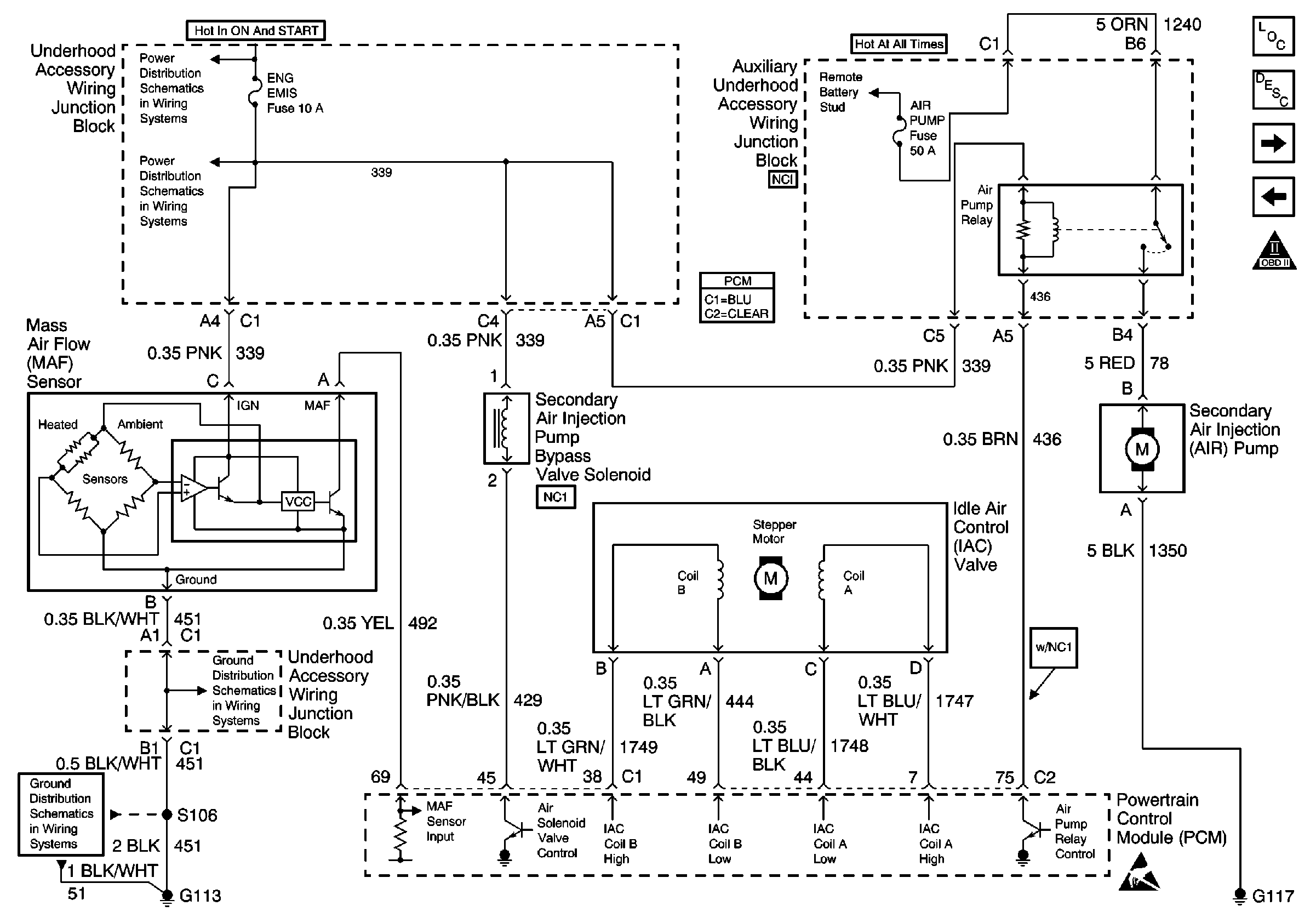Refer to Engine Controls Schematics
MAF, Secondary Air Injection Pump Bypass Solenoid, IAC and Secondary
AIR Pump

.
Circuit Description
The mass air flow (MAF) sensor measures the amount of air that is ingested by the engine. Direct measurement of air entering the engine is more accurate than calculating airflow from other sensor inputs. The MAF sensor has an ignition feed, a ground, and a signal circuit.
The MAF sensor used on this vehicle is a hot wire type and is used to measure air flow rate. The frequency of the MAF sensor signal is a function of the power required to keep the air flow sensing elements at a fixed temperature above ambient temperature. Air flowing through the sensor cools the sensing elements. The amount of cooling is proportional to the amount of air flow. As air flow increases, a greater amount of current is required to maintain the hot wire at a constant temperature. The MAF sensor converts the changes in current draw to a frequency signal read by the powertrain control module (PCM). The frequency typically varies from about 2 KHz at idle to about 10 KHz at maximum engine load. The PCM calculates air flow based on this signal.
The PCM monitors the MAF sensor signal frequency and can determine if the sensor signal voltage is too low, too high, or not indicating the expected airflow for a given operating condition.
Conditions for Running the DTC
| • | The engine is running. |
| • | The throttle position (TP) angle is less than 50 percent. |
| • | The system voltage is more than 8 volts. |
| • | The idle air control (IAC) is above 2 counts |
Conditions for Setting the DTC
| • | The mass air flow (MAF) signal frequency is more than 11,500 Hertz. |
| • | The above conditions are present for approximately 2 seconds |
Action Taken When the DTC Sets
| • | The PCM illuminates the malfunction indicator lamp (MIL) on the second consecutive ignition cycle that the diagnostic runs and fails. |
| • | The PCM records the operating conditions at the time the diagnostic fails. The first time the diagnostic fails, the PCM stores this information in the Failure Records. If the diagnostic reports a failure on the second consecutive ignition cycle, the PCM records the operating conditions at the time of the failure. The PCM writes the conditions to the Freeze Frame and updates the Failure Records. |
The PCM calculates an airflow value based on idle air control valve position, throttle position, RPM and barometric pressure.
Conditions for Clearing the MIL/DTC
| • | The PCM turns the MIL OFF after 3 consecutive drive trips during which the diagnostic runs and passes. |
| • | A last test failed, or the current DTC, clears when the diagnostic runs and passes. |
| • | A History DTC clears after 40 consecutive warm-up cycles, if no other emission related diagnostic failures are reported. |
| • | Use a scan tool in order to clear the MIL diagnostic trouble code. |
| • | Interrupting the PCM battery voltage may or may not clear DTCs. This practice is not recommended. Refer to Powertrain Control Module Description , Clearing Diagnostic Trouble Codes. |
Diagnostic Aids
Notice: Use the connector test adapter kit J 35616-A for any test that
requires probing the following items:
• The PCM harness connectors • The electrical center fuse/relay cavities • The component terminals • The component harness connector
If DTC P0103 cannot be duplicated, the information included in the Fail Records data can be useful in determining vehicle mileage since the DTC was last set.
If the problem is intermittent, refer to Intermittent Conditions .
Test Description
Numbers below refer to the step numbers on the diagnostic table:
-
This step verifies that the problem is present at idle.
-
A frequency reading with the MAF sensor connector disconnected indicates an electromagnetic interference (EMI) related malfunction or a poor connection.
-
This vehicle is equipped with a PCM which utilizes an electrically erasable programmable read only memory (EEPROM). When the PCM is replaced, the new PCM must be programmed.
Step | Action | Value(s) | Yes | No |
|---|---|---|---|---|
1 | Did you perform the Powertrain On-Board Diagnostic (OBD) System Check? | -- | ||
Is MAF Frequency more than the specified value? | 11,500 Hz | |||
3 |
Does the scan tool indicate DTC P0103 failed this ignition? | -- | Go to Diagnostic Aids | |
Does the scan tool indicate MAF Frequency at the specified value? | 0.0 Hz | |||
5 |
Was a problem found and corrected? | -- | ||
6 | Replace the MAF sensor. Refer to Mass Airflow Sensor Replacement . Is the action complete? | -- | -- | |
7 | Check the MAF sensor harness for incorrect routing too close to high voltage or high current components. Was a problem found and corrected? | -- | ||
8 |
Was a problem found and corrected? | -- | ||
|
Important: The replacement PCM must be programmed. Replace the PCM. Refer to Powertrain Control Module Replacement/Programming . Is the action complete? | -- | -- | ||
10 |
Does the scan tool indicate that this test ran and passed? | -- | ||
11 | Review Captured Info using the scan tool. Are there any DTCs that have not been diagnosed? | -- | Go to the applicable DTC table | System OK |
